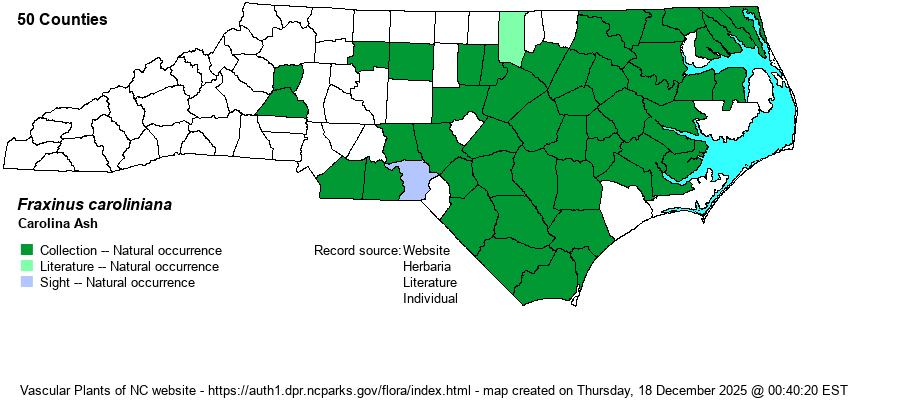| Author | P. Miller | |
| Distribution | Throughout the Coastal Plain, probably in all counties, though a few in the Tidewater region lack records. Also occurs sparingly in the eastern Piedmont, inward to Forsyth and Union counties. Disjunct records in the western Piedmont in Alexander and Catawba counties.
This is a Coastal Plain species, ranging north to southeastern VA and central AR, and south to southern FL and eastern TX. There are few records from the Piedmont province.
| |
| Abundance | Common (and often dominant where found) and reasonably widespread in the Coastal Plain, though apparently uncommon to locally numerous in the Albemarle and Pamlico Sound regions. Rare in the eastern Piedmont; casual in the western Piedmont. Though it is not clear if the emerald ash borer has affected this species in NC yet, NatureServe moved its Global Rank from G5 to now G4. The NCNHP followed suit, moving the State Rank to S4 and adding the species to its Watch List as W5 -- strongly declining. | |
| Habitat | This is strictly a wetland species, found almost always in swamps and other low ground where the base of the tree is in shallow water. It can be found in a variety of situations, from tidal swamps, to blackwater swamps, to brownwater swamps. It is the primary understory tree beneath cypress (Taxodium spp.) and gum (Nyssa spp.) trees in many or most floodplains. |
| Phenology | Flowers mainly in May, and fruits from July to October. | |
| Identification | This well-known deciduous tree (to biologists) is the only species of NC ash that is a small tree, rather than medium to large; it grows mainly to about 40 feet tall, typically with several trunks. It normally has 7-9 leaflets per leaf, with the leaflets somewhat shiny above and elliptical, usually narrowly so, averaging about 4-5 inches long and 2-3 inches wide. Normally, it will be tricky identifying this species by leaflet or leaf characters; so, if in fruit, it is the only ash with samaras that are winged to the base, and the samaras are flattened. Other ashes have samara wings reaching only to the rounded seed, not to the base of the samara. But, in general, the combination of growing in standing water and its small size with usually multiple trunks should be enough for identification. | |
| Taxonomic Comments | None
| |
| Other Common Name(s) | This species has always had several common names in frequent usage. Water Ash and Pop Ash are often seen; Florida Ash and Swamp Ash are also used. | |
| State Rank | S4 | |
| Global Rank | G4 | |
| State Status | W5 | |
| US Status | | |
| USACE-agcp | OBL link |
| USACE-emp | OBL link |

